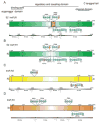Linking structure to function: Recent lessons from inositol 1,4,5-trisphosphate receptor mutagenesis
- PMID: 20510450
- PMCID: PMC3086728
- DOI: 10.1016/j.ceca.2010.04.005
Linking structure to function: Recent lessons from inositol 1,4,5-trisphosphate receptor mutagenesis
Abstract
Great insight has been gained into the structure and function of the inositol 1,4,5 trisphosphate receptor (InsP(3)R) by studies employing mutagenesis of the cDNA encoding the receptor. Notably, early studies using this approach defined the key constituents required for InsP(3) binding in the N-terminus and the membrane spanning regions in the C-terminal domain responsible for channel formation, targeting and function. In this article we evaluate recent studies which have used a similar approach to investigate key residues underlying the in vivo modulation by select regulatory factors. In addition, we review studies defining the structural requirements in the channel domain which comprise the conduction pathway and are suggested to be involved in the gating of the channel.
2010 Elsevier Ltd. All rights reserved.
Figures


Similar articles
-
InsP3R-associated cGMP kinase substrate determines inositol 1,4,5-trisphosphate receptor susceptibility to phosphoregulation by cyclic nucleotide-dependent kinases.J Biol Chem. 2010 Nov 26;285(48):37927-38. doi: 10.1074/jbc.M110.168989. Epub 2010 Sep 27. J Biol Chem. 2010. PMID: 20876535 Free PMC article.
-
Structural and functional conservation of key domains in InsP3 and ryanodine receptors.Nature. 2012 Jan 29;483(7387):108-12. doi: 10.1038/nature10751. Nature. 2012. PMID: 22286060 Free PMC article.
-
The contribution of serine residues 1588 and 1755 to phosphorylation of the type I inositol 1,4,5-trisphosphate receptor by PKA and PKG.FEBS Lett. 2004 Jan 16;557(1-3):181-4. doi: 10.1016/s0014-5793(03)01487-x. FEBS Lett. 2004. PMID: 14741364
-
Regulation of inositol 1,4,5-trisphosphate-induced Ca2+ release by reversible phosphorylation and dephosphorylation.Biochim Biophys Acta. 2009 Jun;1793(6):959-70. doi: 10.1016/j.bbamcr.2008.12.003. Epub 2008 Dec 16. Biochim Biophys Acta. 2009. PMID: 19133301 Free PMC article. Review.
-
Bi-directional signalling from the InsP3 receptor: regulation by calcium and accessory factors.Biochem Soc Trans. 2003 Oct;31(Pt 5):950-3. doi: 10.1042/bst0310950. Biochem Soc Trans. 2003. PMID: 14505456 Review.
Cited by
-
Calcium Unified: Understanding How Calcium's Atomic Properties Impact Human Health.Cells. 2025 Jul 11;14(14):1066. doi: 10.3390/cells14141066. Cells. 2025. PMID: 40710319 Free PMC article. Review.
-
Characterization of ryanodine receptor type 1 single channel activity using "on-nucleus" patch clamp.Cell Calcium. 2014 Aug;56(2):96-107. doi: 10.1016/j.ceca.2014.05.004. Epub 2014 Jun 6. Cell Calcium. 2014. PMID: 24972488 Free PMC article.
-
Region-specific proteolysis differentially regulates type 1 inositol 1,4,5-trisphosphate receptor activity.J Biol Chem. 2017 Jul 14;292(28):11714-11726. doi: 10.1074/jbc.M117.789917. Epub 2017 May 19. J Biol Chem. 2017. PMID: 28526746 Free PMC article.
-
Regulatory Mechanisms of Endoplasmic Reticulum Resident IP3 Receptors.J Mol Neurosci. 2015 Aug;56(4):938-948. doi: 10.1007/s12031-015-0551-4. Epub 2015 Apr 10. J Mol Neurosci. 2015. PMID: 25859934 Review.
-
Disease-associated mutations in inositol 1,4,5-trisphosphate receptor subunits impair channel function.J Biol Chem. 2020 Dec 25;295(52):18160-18178. doi: 10.1074/jbc.RA120.015683. Epub 2020 Oct 22. J Biol Chem. 2020. PMID: 33093175 Free PMC article.
References
-
- Furuichi T, Yoshikawa S, Miyawaki A, Wada K, Maeda N, Mikoshiba K. Primary structure and functional expression of the inositol 1,4,5-trisphosphate-binding protein P400. Nature. 1989;342:32–8. - PubMed
-
- Yoshikawa F, Iwasaki H, Michikawa T, Furuichi T, Mikoshiba K. Cooperative formation of the ligand-binding site of the inositol 1,4, 5-trisphosphate receptor by two separable domains. The Journal of biological chemistry. 1999;274:328–34. - PubMed
-
- Yoshikawa F, Morita M, Monkawa T, Michikawa T, Furuichi T, Mikoshiba K. Mutational analysis of the ligand binding site of the inositol 1,4,5-trisphosphate receptor. The Journal of biological chemistry. 1996;271:18277–84. - PubMed
-
- Bosanac I, Alattia JR, Mal TK, Chan J, Talarico S, Tong FK, Tong KI, Yoshikawa F, Furuichi T, Iwai M, Michikawa T, Mikoshiba K, Ikura M. Structure of the inositol 1,4,5-trisphosphate receptor binding core in complex with its ligand. Nature. 2002;420:696–700. - PubMed
Publication types
MeSH terms
Substances
Grants and funding
LinkOut - more resources
Full Text Sources
Other Literature Sources

